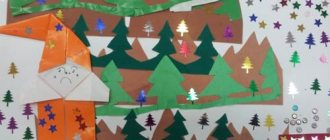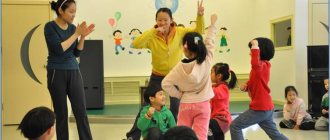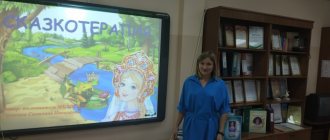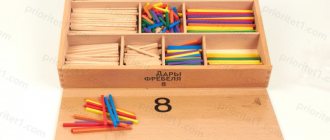Types of music director planning in accordance with Federal State Educational Standards
Larisa Glebovna Vakhrusheva
Types of music director planning in accordance with Federal State Educational Standards
Types of music director planning in accordance with Federal State Educational Standards.
Planning is a necessary element of the system of pedagogical work, contributing to its focus and effectiveness. system for music education in accordance with the Federal State Educational Standard provides for :
1. implementation of program goals and objectives;
2. implementation of the content of educational activities in adequate
age forms of interaction with children;
3. planning of various educational situations in accordance with the annual plan of the educational institution based on integration;
4. availability of a card index of musical repertoire for all types of activities.
The Education Law of the Russian Federation and the Federal State Educational Standard impose new requirements for planning the educational process. I was faced with the task of qualitatively transforming planning and developing new approaches to its implementation, namely
• study of regulatory documents;
• creating a clear, holistic system that takes into account the federal component and the preschool educational institution component.
The tasks of the music education methodology cannot be solved without careful planning and taking into account all the work . Planning allows you to establish connections between all types of musical activities and all forms of its organization. Planning reflects the pace of musical development of each child and the progress of the entire group of children in each age group. Planning outlines what , when and how it is appropriate to apply in the upbringing and education of children.
Planning has the goal of distributing all program material over time. This applies to musical education in classes, in children’s independent and everyday life, and in everyday life.
Music classes are held twice a week. Therefore, when planning , you can outline a system for children's musical development . Entertainment, holidays, and the use of music in everyday life are carried out sporadically, but this is also reflected in the plan .
The plan can outline both the long term and specific tasks for the coming days. Some teachers have doubts about whether a long-term plan for a long period, for example, 2-3 months or six months. But there are many arguments in favor of the need for long-term planning in the field of music education . After all, the program is only a guideline, although it determines the entire course of work. The specific conditions of each kindergarten - the natural environment, the composition of the children, the room in which the lesson is planned - all this and much more must be taken into account.
Planning should clearly represent the sequence of learning each song, dance, round dance, i.e., outline the tasks of working on them over several lessons and the timing of their reuse. Musical education is carried out mainly by the music director , but the teacher takes part in all musical , educational and educational activities, and is the main one in guiding the independent musical activities of children. That is why the long-term plan should be drawn up by them together, and the calendar plan should be drawn up primarily by the music director .
So, it is advisable to draw up two types of plan :
1. Long-term, designed for 6 - 12 months.
2. Calendar (daily, designed for 1-2 weeks.
In the first of these plans, a distant goal is planned , in the second, immediate tasks are planned .
The calendar plan of music classes reflects educational tasks, acquired and developed skills, as well as the repertoire and some of the most essential methodological techniques. The calendar plan is drawn up for 1-2 weeks, i.e. 2 or 4 classes are planned . During music classes, there is a change in materials and activities, so it is advisable to reflect the course of the lesson in the plan . We must strive to ensure that the lesson is condensed and clear in its organization.
The calendar plan reflects :
1. sequence of the material to be learned;
2. program requirements that are being worked on in connection with the intended repertoire;
3. some methodological techniques.
To evaluate the planning of musical work in kindergarten, it is necessary to consider general trends that are actively being developed and are fundamental in modern music pedagogy and should be reflected in the work on the musical development of children .
The first trend is the upbringing and training of a child in a children's group and through a group. It is important to observe and guide the collective actions of children, which contain great reserves for the formation of the personality of each child, for his musical development .
The second trend is the creation of problematic, search situations in the mental and musical activity of children . To do this, it is necessary to use the following problematic methods, techniques, and special tasks that would put children in unexpected situations that require them to make independent decisions and actions.
An individually differentiated approach requires constant monitoring of the behavior of each child. A longer period is required to identify special musical interests To speed up the identification of the necessary data, you can include special tasks in your classes that will help reveal the individual characteristics of children. Typically, a lesson includes 2-3 tasks, depending on the time available. By the end of September, the teacher should already have data on the child’s musical development . Children perceive such tasks as part of a general lesson, without feeling that they are being tested.
However, these test tasks should not be short and clear, nor require much time to complete. For example, the peculiarities of music and the skill of distinguishing two works are clarified. Children aged 4-5 years are different in character and genre. For this, children are offered 2 cards: on one - a dancing child, on the other - a marching child. Cards are distributed to 7-9 children at once. The works are performed one after another, and the child. Distinguishing them, you must understand the corresponding card . The teacher notes who made a mistake. Another example is also for the middle group. The teacher checks whether the skill of accurately starting singing after the musical introduction . 4-5 children are interviewed at once, and the children should start singing a well-known song exactly after the introduction. It is easy to determine which child succeeded. Similar tasks are selected for each type of activity.
As a result of accumulated observations, the teacher or music director has the opportunity to conditionally classify the child into one or another group of children with similar knowledge and skills. Further guidance of children’s musical activities is built taking into account their individual characteristics, as well as the characteristics of each group.
Typically, children are divided into three groups, differing in their level of musical development : the first of them is poorly prepared, the second is well-performing, and the third is excellent at completing tasks. When planning a calendar lesson , you can note which task is performed by all children frontally, which by a small subgroup, differentiated, and which individually.
MAGAZINE Preschooler.RF
Outline of the lesson of the educational activity “Music” for children of the senior group of the preschool educational institution “Song. Dance. March"Musical director Solyanik Yu.N.
Target:
- introduce children to the national anthem of the Russian Federation, determine its genre
Tasks:
- continue to expand children’s understanding of musical genres, be able to distinguish between a song, dance, and march
- continue to develop in children the ability to feel the character and mood of the muses. works; encourage children to speak out about its content
- learn to recognize works of music. works in separate fragments, name the composer
- develop the ability to listen and feel music
- expand the “dictionary of emotions” with the phrase “Solemn music”
- cultivate a sense of patriotism, love and respect for the Motherland
- perform songs, carefully intoning the melody, emotionally conveying its character
- teach to perform dance-rhythmic movements in the appropriate character of the music. works
- foster a sense of friendship
Equipment: music instrument (digital piano), MMP, Interactive screen, laptop, portraits of composers, “Song. Dance. March" -MDI, notebook with cards, bells,
bells, interactive book, mask
Plan:
On the screen is a slide “Fairy Domisolka” , children enter the hall and greet the muses. leader and guests.
M.R.: Guys, did you notice that we greeted you differently than usual? What is missing for our greeting?
Children: music.
M.R.: That's right! look, the fairy of music Domisolka flew to us and brought with her a magic envelope. Let's see what's in it?
M.R. takes the envelope and opens it
M.R. and here is a mystery. Can you solve riddles? Then listen:
My house is five lines, And I am the key to the doors. Nobody will be able to open the door. Me myself! I'll open the door
Musician, singer. And my notes suit the songs very well (Treble clef)
That's right, it's a treble clef. There are two clefs in the envelope here - which one is the treble clef? (Children call)
Let's place the treble clef on the staff, then the door to the world of music will be open for us!
(I set the treble clef and play arpeggios on the piano)
Slide “Musical House”
So music appeared in our hall! Thanks to the Fairy and the treble clef. Now let's say hello like real musicians!
Singing “Good afternoon!” (incrementally upward by third)
And now let’s say hello to the guests in the same way.
Singing “Good afternoon, guests!”
Slide “Dance. March"
Domisolka wants to see how well you can move to the music. Shall we show the fairy?
Exercise “Dance. March" :
- "March" of music. D. Shostakovich
- "Waltz" music. D. Kabalevsky
- “There was a birch tree in the field”
- "March" of music. D. Prokofiev
- "Polka" - music. S. Maikapara
Well done! Everything was done correctly.
Slide “Singing Children”
Now the Fairy wants you to know about a new song.
Sit down on the chairs and listen to what song Domisolka has prepared.
Slide “Flag of the Russian Federation”
Guys, it is no coincidence that you see the flag of our country in front of you. What is the name of our country? (Russia)
That's right, Russia! Our beloved Motherland! Our country Russia has its own most important song - it is called the anthem.
Let's listen to her. (The Russian Anthem plays in the recording)
Did you like the anthem? What does his music sound like? At what pace? Loud or Quiet?
You said everything correctly, but I also want to add that the anthem sounds solemn. Let's repeat this new word together, solemnly. There is a special rule for listening to the anthem - it is listened to while standing as a sign of respect and love for the country. Let us stand up and, like real citizens of Russia, listen to the anthem once again while standing.
(children stand up, the Russian anthem sounds, after listening, children sit down)
Did you like the song that the fairy prepared for you? What is it called? How does it sound? (solemnly)
Well done! And now Domisolka wants to play the game “Song” with you. Dance. March" . Do you love games? The fairy has prepared special cards for you, on each card there is a picture of a child - one is dancing (I put a magnet of a dancing child on a notebook), another is singing (I put a magnet with a singing child), and the third child is marching (I put a child who is walking). Listen carefully to the music and pick up the card that matches the music being played.
Slide “Song. Dance. March"
Music:
- “March” D. Shostakovich-portrait
- “Waltz” D. Kabalevsky-portrait
- “There was a birch tree in the field” (I sing a capella)
- “March” S. Prokofiev – portrait
- "Kalinka" - interactive book
“March of the Wooden Soldiers” P. Tchaikovsky-portrait
- “Minuet” by J. S. Bach
- "Anthem of the Russian Federation"
Well done! Guys, but there is no music without musical instruments? What Russian musical instruments do you know? (Spoons, tambourine, balalaika, pipe, horn, accordion, bells, bell)
Slide “Jells, bell”
Bells are small ringing round bells. You see them on the screen
Do we know the song about bells? Let's sing it.
“Jingle bells” - music. E. Tilicheeva (chorus)
And bells also have bell friends. Look, the bell in the picture is decorated with a spruce branch and bright ribbons. What holiday was he decorated like that for? (N.G.) You and I are also preparing for this holiday and have prepared the song “Singing Bells” . Let's sing this song for the fairy Domisolka, and the bells will help us with this.
Song "Singing Bells" by Amer. adv. song, russian text by Y. Khazanov
Guys, at what time of year does the New Year holiday come to us? (winter)
Slide “Winter”
Our Russian winter is known for its winter holidays, snowfalls, games, and also severe frosts. Are you afraid of frost? (no) That one is not afraid of frost. who knows how to have fun! Let's play the game "You, Frost!"
Slide “Moroz Ivanovich”
Game "You, Frost!"
Did you enjoy completing Domisolka’s tasks and playing? What did you like most today?
The fairy also really liked you and she has prepared a surprise for you - it’s here, in a magic box. Let's see what's there? Guys, Domisolka gives each of you a treble clef so that the door to the magical world of music will always be open for you!
Slide “Magic notes”
Music "Waltz of Snowflakes"
(handing out treble clefs)
Children say goodbye by singing “Goodbye!”
Children leave the hall to cheerful music.
| Next > |





